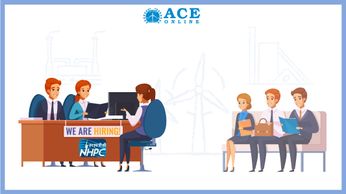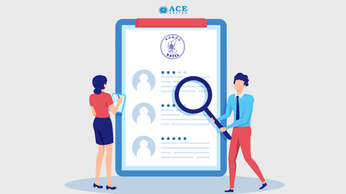
Everything About SSC JE EXAM
SSC Junior Engineer Exam Syllabus , Exam Pattern, Previous Year Exam Papers for Junior Engineer Posts
About the SSC JE Exam
SSC JE Junior Engineer exam is a national level exam conducted at State level and Central level once a year. Staff Selection Commision (SSC) Every year it is about to hire over 200 Junior Engineers from Electrical, Civil, Mechanical, and Quantity Surveying & Contracts branches from Engineering. Each and Depends upon the number of applications received by the candidates the cut-off is changed every year. SSC Junior Engineer exam is conducted in both Hindi and English Languages.
SSC JE Exam Highlights
Name of the Exam | SSC JE |
Conducting Authority | Staff Selection Commission (SSC) |
Age Limit | 30 years to 32 years |
Mode of Examination |
|
Official Website | |
Stages of Exam |
|
SSC JE Eligibility Application Fee |
|
SSC JE Eligibility |
|
SSC JE Eligibility Exam Locations | Central Region
Eastern Region
Karnataka, Kerala Region (KKR)
Madhya Pradesh Sub-Region (MPR)
North Eastern Region (NER)
Northern Region (NR)
North Western Sub-Region (NWR)
Southern Region (SR)
Western Region (WR)
|
Syllabus |
|
Type of Questions | Paper - 1
Paper - 2
|
Marks | Paper - 1
Paper - 2
|
Duration | 2 Hours |
Language of paper | English & Hindi |
Negative Marking | Paper - 1
Paper - 2
|
SSC JE Exam Pattern
Papers/Stage | Subject | No of Questions/ Maximum marks |
Stage - 1 Paper-I
| Part -1
Part -2 - Engineering Subject
| 200 Marks |
Stage -2 Paper-II
| Written Exam Paper - Engineering Subject
| 300 Marks |
Stage 3 | Document Verification | No Marks |
Stage - 4 | Medical Examination | No Marks |
Total Marks | 500 Marks | |
SSC JE Exam Syllabus
Paper - 1 | |
Part - 1
Verbal and non-verbal - Analogies, similarities, differences, space visualization, problem solving, analysis, judgement, decision making, visual memory, discrimination, observation, relationship concepts, arithmetical reasoning, verbal and figure classification, arithmetical number series, abstract ideas, symbols and their relationships, arithmetical computations and analytical functions.
History, Culture of India, Geography, Economic Scene, General Polity, Scientific Research, Current events of matters of+ everyday observations & experience in the scientific aspect, India and its neighboring countries, Awards and Honors, Government Schemes | |
Part 2 Part A - Civil Engineering (i) Building Materials, Estimating, Costing and Valuation, Surveying, Soil Mechanics, Hydraulics, Irrigation Engineering, Transportation Engineering, Environmental Engineering. Structural Engineering: Theory of Structures, Concrete Technology, RCC Design, Steel Design. Part-B - Electrical Engineering (ii) Basic concepts, Circuit law, Magnetic Circuit, AC Fundamentals, Measurement and Measuring instruments, Electrical Machines, Fractional Kilowatt Motors and single phase induction Motors, Synchronous Machines, Generation, Transmission and Distribution, Estimation and Costing, Utilization and Electrical Energy, Basic Electronics. Part-C - Mechanical Engineering
| |
Paper - 2 | |
Part-A : Civil & Structural Engineering
Building Materials : Physical and Chemical properties, classification, standard tests, uses and manufacture/quarrying of materials e.g. building stones, silicate based materials, cement (Portland), asbestos products, timber and wood based products, laminates, bituminous materials, paints, varnishes. Estimating, Costing and Valuation: estimate, glossary of technical terms, analysis of rates, methods and unit of measurement, Items of work – earthwork, Brick work (Modular & Traditional bricks), RCC work, Shuttering, Timber work, Painting, Flooring, Plastering. Boundary wall, Brick building, Water Tank, Septic tank, Bar bending schedule, Center line method, Midsection formula, Trapezoidal formula, Simpson’s rule. Cost estimate of Septic tank, flexible pavements, Tube well, isolates and combined footings, Steel Truss, Piles and pile-caps. Valuation – Value and cost, scrap value, salvage value, assessed value, sinking fund, depreciation and obsolescence, methods of valuation. Surveying: Principles of surveying, measurement of distance, chain surveying, working of prismatic compass, compass traversing, bearings, local attraction, plane table surveying, theodolite traversing, adjustment of theodolite, Leveling, Definition of terms used in leveling, contouring, curvature and refraction corrections, temporary and permanent adjustments of dumpy level, methods of contouring, uses of contour map, tachometric survey, curve setting, earth work calculation, advanced surveying equipment.Soil Mechanics: Origin of soil, phase diagram, Definitions-void ratio, porosity, degree of saturation, water content, specific gravity of soil grains, unit weights, density index and interrelationship of different parameters, Grain size distribution curves and their uses. Index properties of soils, Atterberg’s limits, ISI soil classification and plasticity chart. Permeability of soil, coefficient of permeability, determination of coefficient of permeability, Unconfined and confined aquifers, effective stress, quick sand, consolidation of soils, Principles of consolidation, degree of consolidation, preconsolidation pressure, normally consolidated soil, e-log p curve, computation of ultimate settlement. Shear strength of soils, direct shear test, Vane shear test, Triaxial test. Soil compaction, Laboratory compaction test, Maximum dry density and optimum moisture content, earth pressure theories, active and passive earth pressures, Bearing capacity of soils, plate load test, standard penetration test. Hydraulics: Fluid properties, hydrostatics, measurements of flow, Bernoulli’s theorem and its application, flow through pipes, flow in open channels, weirs, flumes, spillways, pumps and turbines. Irrigation Engineering: Definition, necessity, benefits, 2II effects of irrigation, types and methods of irrigation, Hydrology – Measurement of rainfall, runoff coefficient, rain gauge, losses from precipitation – evaporation, infiltration, etc. Water requirement of crops, duty, delta and base period, Kharif and Rabi Crops, Command area, Time factor, Crop ratio, Overlap allowance, Irrigation efficiencies. Different types of canals, types of canal irrigation, loss of water in canals. Canal lining – types and advantages. Shallow and deep to wells, yield from a well. Weir and barrage, Failure of weirs and permeable foundation, Slit and Scour, Kennedy’s theory of critical velocity. Lacey’s theory of uniform flow. Definition of flood, causes and effects, methods of flood control, water logging, preventive measure. Land reclamation, Characteristics of affecting fertility of soils, purposes, methods, description of land and reclamation processes, Major irrigation projects in India. Transportation Engineering: Highway Engineering – cross sectional elements, geometric design, types of pavements, pavement materials – aggregates and bitumen, different tests, Design of flexible and rigid pavements – Water Bound Macadam (WBM) and Wet Mix Macadam (WMM), Gravel Road, Bituminous construction, Rigid pavement joint, pavement maintenance, Highway drainage, Railway Engineering- Components of permanent way – sleepers, ballast, fixtures and fastening, track geometry, points and crossings, track junction, stations and yards. Traffic Engineering – Different traffic surveys, speed-flow-density and their interrelationships, intersections and interchanges, traffic signals, traffic operation, traffic signs and markings, road safety. Environmental Engineering: Quality of water, source of water supply, purification of water, distribution of water, need of sanitation, sewerage systems, circular sewer, oval sewer, sewer appurtenances, sewage treatments. Surface water drainage. Solid waste management – types, effects, engineered management system. Air pollution – pollutants, causes, effects, control. Noise pollution – cause, health effects, control.
Theory of structures: Elasticity constants, types of beams – determinate and indeterminate, bending moment and shear force diagrams of simply supported, cantilever and overhanging beams. Moment of area and moment of inertia for rectangular & circular sections, bending moment and shear stress for tee, channel and compound sections, chimneys, dams and retaining walls, eccentric loads, slope deflection of simply supported and cantilever beams, critical load and columns, Torsion of circular section. Concrete Technology: Properties, Advantages and uses of concrete, cement aggregates, importance of water quality, water cement ratio, workability, mix design, storage, batching, mixing, placement, compaction, finishing and curing of concrete, quality control of concrete, hot weather and cold weather concreting, repair and maintenance of concrete structures. RCC Design: RCC beams-flexural strength, shear strength, bond strength, design of singly reinforced and doubly reinforced beams, cantilever beams. T-beams, lintels. One way and two way slabs, isolated footings. Reinforced brick works, columns, staircases, retaining wall, water tanks (RCC design questions may be based on both Limit State and Working Stress methods). Steel Design: Steel design and construction of steel columns, beams, roof trusses, plate girders. Part - B: Electrical Engineering Basic concepts : Concepts of resistance, inductance, capacitance, and various factors affecting them. Concepts of current, voltage, power, energy and their units. Circuit law : Kirchhoff’s law, Simple Circuit solution using network theorems. Magnetic Circuit: Concepts of flux, mmf, reluctance, Different kinds of magnetic materials, Magnetic calculations for conductors of different configuration e.g. straight, circular, solenoidal, Electromagnetic induction, self and mutual induction. AC Fundamentals: Instantaneous, peak, R.M.S. and average values of alternating waves, Representation of sinusoidal waveform, simple series and parallel AC Circuits consisting of R.L. and C, Resonance, Tank Circuit. Polyphase system – star and delta connection, 3 phase power, DC and sinusoidal response of R-Land R-C circuit. Measurement and measuring instruments: Measurement of power (1 phase and 3 phase, both active and reactive) and energy, 2 wattmeter method of 3 phase power measurement. Measurement of frequency and phase angle. Ammeter and voltmeter (both moving oil and moving iron type), extension of range wattmeter, Multimeters, Megger, Energy meter AC Bridges. Use of CRO, Signal Generator, CT, PT and their uses. Earth Fault detection. Electrical Machines : (a) D.C. Machine – Construction, Basic Principles of D.C. motors and generators, their characteristics, speed control and starting of D.C. Motors. Method of braking motor, Losses and efficiency of D.C. Machines. (b) 1 phase and 3 phase transformers – Construction, Principles of operation, equivalent circuit, voltage regulation, O.C. and S.C. Tests, Losses and efficiency. Effect of voltage, frequency and wave form on losses. Parallel operation of 1 phase /3 phase transformers. Auto transformers. (c) 3 phase induction motors, rotating magnetic field, principle of operation, equivalent circuit, torque-speed characteristics, starting and speed control of 3 phase induction motors. Methods of braking, effect of voltage and frequency variation on torque speed characteristics. Fractional Kilowatt Motors and Single Phase Induction Motors: Characteristics and applications. Synchronous Machines - Generation of 3-phase e.m.f. armature reaction, voltage regulation, parallel operation of two alternators, synchronizing, control of active and reactive power. Starting and applications of synchronous motors. Generation, Transmission and Distribution: Different types of power stations, Load factor, diversity factor, demand factor, cost of generation, inter-connection of power stations. Power factor improvement, various types of tariffs, types of faults, short circuit current for symmetrical faults. Switchgears: rating of circuit breakers, Principles of arc extinction by oil and air, H.R.C. Fuses, Protection against earth leakage / over current, etc. Buchholtz relay, Merz-Price system of protection of generators & transformers, protection of feeders and bus bars. Lightning arresters, various transmission and distribution systems, comparison of conductor materials, efficiency of different systems. Cable – Different types of cables, cable rating and derating factor. Estimation and costing: Estimation of lighting scheme, electric installation of machines and relevant IE rules. Earthing practices and IE Rules. Utilization of Electrical Energy: Illumination, Electric heating, Electric welding, Electroplating, Electric drives and motors. Basic Electronics: Working of various electronic devices e.g. P N Junction diodes, Transistors (NPN and PNP type), BJT and JFET. Simple circuits using these devices. Part- C: Mechanical Engineering
Power transmission by belts – V-belts and Flat belts, Clutches – Plate and Conical clutch, Gears – Type of gears, gear profile and gear ratio calculation, Governors – Principles and classification, Riveted joint, Cams, Bearings, Friction in collars and pivots. Engineering Mechanics and Strength of Materials Equilibrium of Forces, Law of motion, Friction, Concepts of stress and strain, Elastic limit and elastic constants, Bending moments and shear force diagram, Stress in composite bars, Torsion of circular shafts, Buckling of columns – Euler’s and Rankin’s theories, Thin walled pressure vessels.
Properties of Pure Substances : p-v & P-T diagrams of pure substance like H2O, Introduction of steam table with respect to steam generation process; definition of saturation, wet & superheated status. Definition of dryness fraction of steam, degree of superheat of steam. H-s chart of steam (Mollier’s Chart). 1 st Law of Thermodynamics : Definition of stored energy & internal energy, 1st Law of Thermodynamics of cyclic process, Non Flow Energy Equation, Flow Energy & Definition of Enthalpy, Conditions for Steady State Steady Flow; Steady State Steady Flow Energy Equation. 2 nd Law of Thermodynamics : Definition of Sink, Source Reservoir of Heat, Heat Engine, Heat Pump & Refrigerator; Thermal Efficiency of Heat Engines & co-efficient of performance of Refrigerators, Kelvin – Planck & Clausius Statements of 2nd Law of Thermodynamics, Absolute or Thermodynamic Scale of temperature, Clausius Integral, Entropy, Entropy change calculation of ideal gas processes. Carnot Cycle & Carnot Efficiency, PMM-2; definition & its impossibility. Air standard Cycles for IC engines : Otto cycle; plot on P-V, T-S Planes; Thermal Efficiency, Diesel Cycle; Plot on P-V, T-S planes; Thermal efficiency. IC Engine Performance, IC Engine Combustion, IC Engine Cooling & Lubrication. Rankine cycle of steam : Simple Rankine cycle plot on P-V, T-S, h-s planes, Rankine cycle efficiency with & without pump work. Boilers; Classification; Specification; Fittings & Accessories : Fire Tube & Water Tube Boilers. Air Compressors & their cycles; Refrigeration cycles; Principle of a Refrigeration Plant; Nozzles & Steam Turbines
Properties & Classification of Fluid : ideal & real fluids, Newton’s law of viscosity, Newtonian and Non-Newtonian fluids, compressible and incompressible fluids. Fluid Statics : Pressure at a point. Measurement of Fluid Pressure : Manometers, U-tube, Inclined tube. Fluid Kinematics : Streamline, laminar & turbulent flow, external & internal flow, continuity equation. Dynamics of ideal fluids : Bernoulli’s equation, Total head; Velocity head; Pressure head; Application of Bernoulli’s equation. Measurement of Flow rate Basic Principles : Venturimeter, Pilot tube, Orifice meter. Hydraulic Turbines : Classifications, Principles. Centrifugal Pumps : Classifications, Principles, Performance.
Classification of Steels : Mild steel & alloy steel, Heat treatment of steel, Welding – Arc Welding, Gas Welding, Resistance Welding, Special Welding Techniques i.e. TIG, MIG, etc. (Brazing & Soldering), Welding Defects & Testing; NDT, Foundry & Casting – methods, defects, different casting processes, Forging, Extrusion, etc, Metal cutting principles, cutting tools, Basic Principles of machining with (i) Lathe (ii) Milling (iii) Drilling (iv) Shaping (v) Grinding, Machines, tools & manufacturing processes. |
SSC JE Questions Papers
SSC JE Electrical Question Papers
Question Papers | Download |
SSC JE Electrical Paper 22 January 2018 | |
SSC JE Electrical Paper 23 January 2018 | |
SSC JE Electrical Paper 27 January 2018 | |
SSC JE Electrical Paper 25 January 2018 | |
SSC JE Electrical 2021 All Shift Question Paper PDF in English | |
SSC JE Electrical 2021 All Shift Question Paper PDF in English | |
SSC JE Electrical 2021 All Shift Question Paper PDF in English |
SSC JE Civil Question Papers
SSC JE Civil Engineering January 22, 2018 | |
SSC JE Civil Engineering January 22, 2018 | |
SSC JE Civil Engineering January 23, 2018 | |
SSC JE Civil Engineering January 24, 2018 | |
SSC JE Civil Engineering January 27, 2018 | |
SSC JE Civil Engineering January 29, 2018 | |
SSC JE Civil Engineering January 29, 2018 | |
SSC JE Civil 2021 All Shift Question Paper PDF in English |
SSC Junior Engineer Civil Previous Papers
SSC JE Civil Previous Papers |
SSC JE Mechanical Question Papers
SSC Jr. Engineer Mechanical Model Question Paper | |
SSC JE Mechanical 2021 All Shift Question Paper PDF in English | |
SSC JE Mechanical Previous Year Paper |
Crack the upcoming SSC Exam through Best Coaching for GATE
Need more details about SSC Exams? Subscribe and Follow our blog for more Info.
For more suggestions and preparation strategies, Follow our blog. ALL THE BEST
Subscribe our YouTube Channel for more updates https://bit.ly/3I1PDWs
For simple and smooth learning follow us on Facebook https://bit.ly/3uUG47W
Easy to learn, simple to remember follow us on Instagram https://bit.ly/3oTntVU
Download our android app to receive updates https://bit.ly/3HY20CS
Connect with knowledge - To Download our windows app https://bit.ly/3LGyVOg
Think bigger, Learn Smarter, Download our iOS app https://apple.co/3LFzwzO
ACE Online Newsletter
Join the newsletter to receive the latest updates in your inbox.






